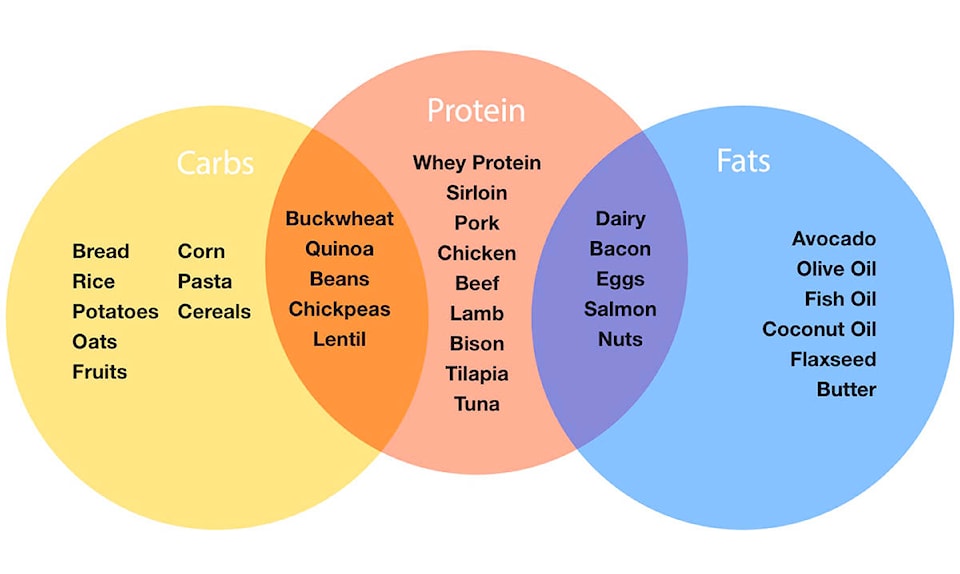Macros is short for macronutrients. It is a term used to reference the ratio of fat, protein and carbohydrate within an individual’s diet. Calories are an important factor when you’re trying to burn body fat, but calories aren’t the only factor. Your macro choices are more critical.
Carbohydrates provide few benefits other than energy. Few people realize that, out of the three macronutrients, carbohydrates are the only ones that are not essential. There are essential amino acids and essential fats, which your body can’t produce on its own, but there are no essential carbohydrates. Your body can produce enough carbohydrates, mainly in your liver, from the protein and fat you consume.
This doesn’t mean that carbs are a demon, but if you’re trying to lose body fat while building muscle and strength, you want to focus on eating protein, fat and vegetables. Ensuring enough vitamins, minerals and fibre is essential and vegetables are a great supply for this.
Carbohydrates are broken into two categories: high glycemic and low glycemic. When you eat high-glycemic carbs, your body processes them rapidly, absorbs them in the intestines, and shoves them right into your bloodstream. This increases your blood glucose levels, which spikes insulin. An insulin spike can be useful after a workout, but it’s not great at any other time of day. Examples of high glycemic carbs are: potatoes, white rice and breads, some fruits like bananas and tropical fruits and, of course, all sweets. Low glycemic do not digest as rapidly. They don’t create the same sharp spike in blood glucose, so they offer a steadier supply of energy. Examples of low glycemic carbs are: whole grains, yams or sweet potatoes, legumes, fruits and some vegetables. Only eat high-glycemic carbs after training. Eat low-glycemic carbs at any other time of day.
Protein is the most critical macronutrient on the building of muscle and leaning out. Muscle is made out of protein, which is essential for muscle growth, repair, and recovery. It’s also a critical fuel source. Your body can break protein down and use amino acids as a muscular energy source. Research suggests that high-protein, low-carbohydrate diets work well for fat loss. This is particularly true for those trying to maintain or build lean muscle at the same time. It’s difficult for the body to take protein and convert it into body fat. It’s not impossible, but out of the three macronutrients, the body has to work hardest to convert protein into body fat.
It’s either going to use protein to synthesize tissue or break it down for energy. Protein is a home run when it comes to dropping body fat, building muscle and gaining strength. Good protein sources are lean cuts of meat such as top sirloin, flank steak, lean ground beef; poultry: chicken and turkey, white and dark meat; fish: halibut, sole, salmon; eggs/dairy: whey, casein, Greek yogurt, cottage cheese; plants: soy, beans, nuts, grains, etc.
Fat is not the enemy. Eating fat doesn’t necessarily make you fat, but certain fats are better than others. Fat is the second most critical macronutrient. Types of fats are: monounsaturated, polyunsaturated, such as Omega-3 fats, saturated and trans-fatty acids. Omega-3 fatty acids are an essential polyunsaturated fat. They’re called “essential” because your body can’t produce them on its own. They also offer a wide range of health benefits.
For example, they’ve been shown to enhance fat loss by turning on genes that increase fat burning. They also help decrease fat storage. Omega-3 fats produce beneficial prostaglandins that decrease inflammation. They’ve been found to increase muscle recovery and growth, and they support skin, vision, and brain health. Omega-3s are found in fatty fish, like salmon and tuna. If you eat canned tuna, choose white albacore over chunk light. Even sardines fit the profile. Saturated fat is not the enemy either. It is critical when you’re training intensely. Saturated fat promotes healthy testosterone levels and is especially important to men. You want to maintain your testosterone levels to build muscle and strength, train harder, recover better and lose more fat.
Calories per gram for fat are nine, whereas protein and carbs are four. Because fats are calorie-dense, fats can push you over your daily calorie limit which is why it is important when calculating your daily calorie requirement, you must adjust all three macros to a ratio that works for you and your caloric intake levels, whether you are trying to maintain your body weight or trying to shed pounds you must adjust your macros to one that allows you to safely and healthily do so.
The standard ratio for macros given by most nutritional apps and the Canada Food Guide is 50 per cent carbs, 30 per cent fat and 20 per cent protein. This is too high of a carbohydrate ratio in my opinion and why it is challenging for a lot of people to lose weight, build muscle or maintain good energy levels. If you choose nutritionally dense food and drink adequate amounts of water, my advice to a lot of people is to carb cycle until you find a ratio that works best for you!
This will look differently for many people depending on their goals and lifestyle habits. If you are unsure where to start, seeking professional help with this is a definite must. A personal trainer can guide you with this, as can a nutritionist and naturopathic doctor.
(Nicole Cournoyer is the general manager of Anytime Fitness in Chemainus).
